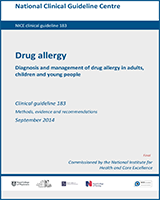From: 9, Documenting and sharing information with other healthcare professionals

Drug Allergy: Diagnosis and Management of Drug Allergy in Adults, Children and Young People.
NICE Clinical Guidelines, No. 183.
National Clinical Guideline Centre (UK).
London: National Institute for Health and Care Excellence (NICE); 2014 Sep.
Copyright © National Clinical Guideline Centre, 2014.
NCBI Bookshelf. A service of the National Library of Medicine, National Institutes of Health.